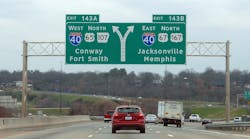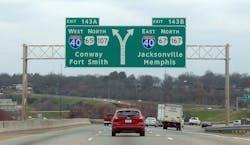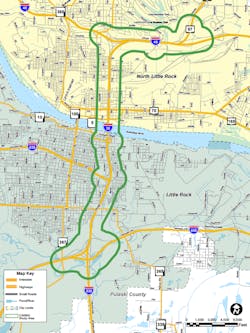Who doesn’t like to hear that an outdated, crowded stretch of critical freeway is getting a major overhaul and expansion? Well, plenty of folks in my hometown of Little Rock, apparently. Along with deserving an entry in the be-careful-what-you ask-for catalog, the kerfuffle is just another example of how complicated major road projects can be—and why trucking needs a robust highway bill.
Indeed, on a national level this is just one case of the hundreds and hundreds of major projects on drawing boards around the country: They are difficult for a variety of reasons, yet uncertainty about federal highway funding makes them nearly impossible to complete in a timely manner.
The Arkansas basics: The state’s voters approved a special tax to fund a number of highway projects, including adding capacity to the I-30/I-40 interchange at the Arkansas River, which splits Little Rock and N. Little Rock. The current layout was designed in the 1960s and the ramps in downtown Little Rock are a mess.
The interchange is the most congested in Arkansas, with typical rush hour traffic jams made worse by regular accidents that are often the result of merging problems from those outdated onramps. Although it doesn’t make the ATRI list of trucking’s top bottlenecks, the Interstate connector does carry freight traffic up from Dallas to join the major east-west flow on I-40, so—as with many local traffic problems—there is a much wider impact.
With tax projections in hand, the Arkansas Highways and Transportation Dept. went to work on a plan. The resulting design would widen the bridge from 6 lanes to 10, and completely relocate the access points. But when the proposal starting making the public presentation and approval rounds, it was met with some initial local resistance that has since snowballed.
The problem is that both Little Rock and N. Little Rock have been working to redevelop the downtown riverfronts, and have had quite of bit of success. Future redevelopment projects are focused east of the I-30, to take advantage of the popularity of the Clinton Presidential Library and the Heifer International sustainability showcase next door. This is a part of the city that has been long neglected as Little Rock expanded westward.
But the AHTD plan would create a barrier that makes east-end integration with downtown all but impossible. Some Little Rock leaders have argued that city has no reason to support a highway plan that simply makes it easier for commuters to get to the suburbs and that, historically, added capacity simply adds more traffic. Local policy makers would prefer the money to be spent on alternative routes, ideally rerouting through-traffic away from the downtown Interstate crossing altogether.
But, even though Little Rock is the state capital and traditional financial center, the “big city” has long been a low priority for a state legislature dominated by rural interests. Essentially, the very powerful highway department can do what it wants, and theoretically that’s what’s best for the entire state.
The offices of the Arkansas Trucking Assn. are across the street from the capitol building, and ATA President Shannon Newton says she expects city and highway department planners will overcome “competing interests” and come up with a mutually beneficial solution—and one that allows interstate freight to move efficiently, she emphasizes.
“It’s a bottleneck,” Newton says. “Little Rock has to have reverence for the traffic that needs to move through the city. The highway department’s job is to maintain the flow. It can’t control bottlenecks in Atlanta or New Jersey, but it can fix the problem here with money that was approved in a special election.”
Full disclosure: I’ve been badgering Congress in print for a number of years about the need for a long-term federal surface transportation spending program to replace good ol’ SAFTEA-LU. Indeed, we’ve gone more years without a long-term plan than the George W. Bush-era plan lasted, give or take a dozen or more extensions to it and its successor, MAP-21.
And with a new, multi-year plan being debated in a House-Senate conference, regular readers might assume I’ll have to find something new, thank goodness, to whine about. Except, of course, nothing has been easy for Congress for a quite some time, and there’s certainly a chance that the talks will crater next week without delivering a compromise plan suitable for both chambers, both parties, and the White House.
It’s not the job of Congress to figure out how to solve the Little Rock problem, but it is their job to help fund the Interstate system. Without reliable federal support, local projects will increasingly be designed by the people paying for them—and that’s fair. It’s just no way to run a transcontinental supply chain that supports a global economy.







